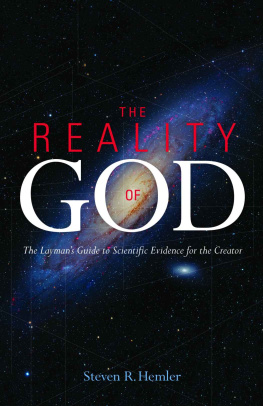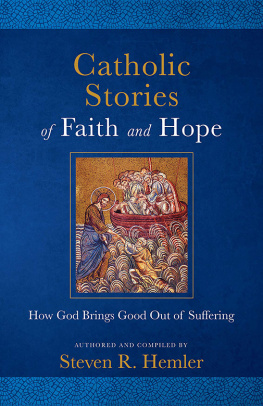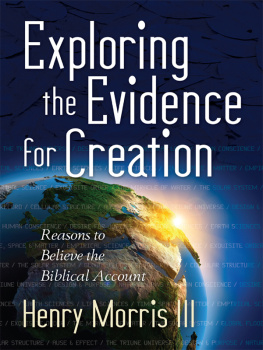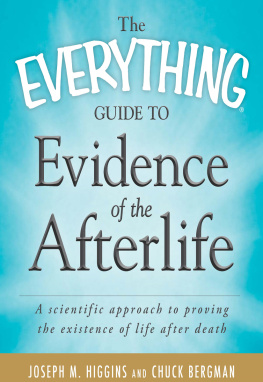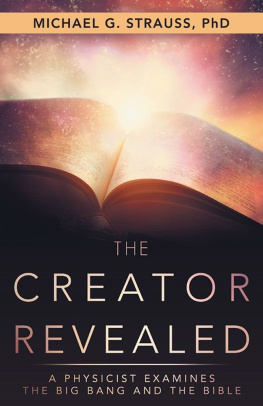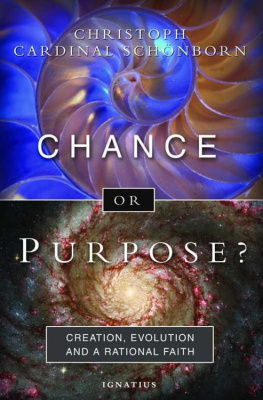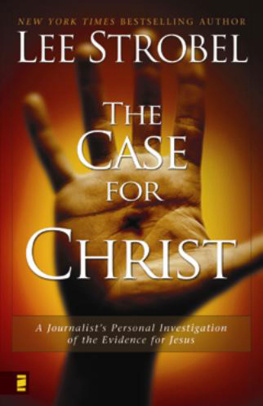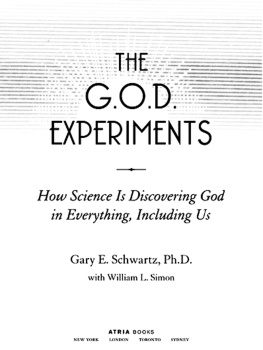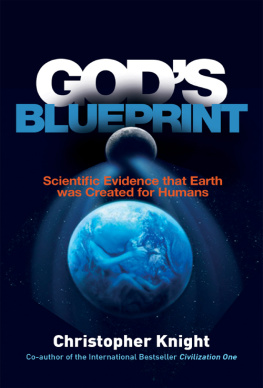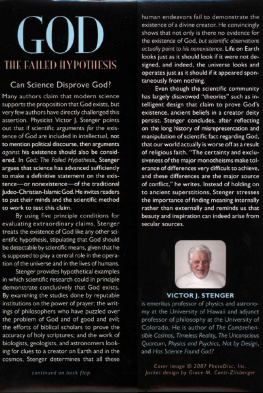THE REALITY
OF GOD
THE REALITY
OF GOD
THE LAYMANS GUIDE TO SCIENTIFIC EVIDENCE FOR THE CREATOR
Steven R. Hemler
Saint Benedict Press
Charlotte, North Carolina
Nihil Obstat:Rev. Paul deLadurantaye, S.T.D.
Censor Librorum
Imprimatur : W Paul S. Loverde
Bishop of Arlington
January 14, 2014
Copyright 2014 Steven R. Hemler
All rights reserved. With the exception of short excerpts used in articles and critical review, no part of this work may be reproduced, transmitted, or stored in any form whatsoever, printed or electronic, without the prior written permission of the publisher.
Cataloging-in-Publication data on file with the Library of Congress
Cover design by David Ferris
www.davidferrisdesign.com
Cover image: Getty Images / Marco Lorenzi,
www.glitteringlights.com
ISBN: 978-1-61890-218-4
Published in the United States by
Saint Benedict Press, LLC
PO Box 410487
Charlotte, NC 28241
www.SaintBenedictPress.com
Printed and bound in the United States of America
CONTENTS
God Is...
Personal Reflection/Discussion Questions
for Part I
God Is...
Personal Reflection/Discussion Questions
for Part II
God Is...
Personal Reflection/Discussion Questions
for Part III
ACKNOWLEDGMENTS
I gratefully acknowledge the many contributions of family and friends in the development of this book. I am very grateful for the review comments and excellent suggestions provided by Fr. Peter Reynierse, Fr. Paul Koenig, Dr. Anthony Foster, Susan and Mark Hope, Jill Devine, Bob Wiersberg, Jon Brick, Billie Marie Springart, Scott Hemler, Dan Marcum, Randy Hyde, Dave Hrivnak, and several others. I am also very appreciative of Sr. Mary Margaret Ann Schlather and Carol Daley of Catholic Distance University for implementing a new three-week apologetics seminar on evidence for Gods existence, as it was this online seminar that prompted me to adapt several of our apologetics presentations into the text-based lecture format that was the basis of this book. The help of R. C. and Marc Garcia in developing the initial draft of these seminar lectures was invaluable. Of course, I am especially grateful for the love and support of my wife, Linda, and our children, Jonathan, Christopher, and Allison. I have been truly blessed with a wonderful wife and fantastic children. May God bless everyone involved in this labor of love and all those who read this book, which was prepared to help manifest Gods majesty as revealed in His creation.
PREFACE
The question Does God exist? is critical to understanding our place in the universe and how we will live our lives. Thats because what someone believes about God affects everything else he or she believes and does. Indeed, the five most consequential questions in life are these:
1.Origin: Where did we come from?
2.Identity: Who are we?
3.Meaning: Why are we here?
4.Morality: How should we live?
5.Destiny: Where are we going?
Our answer to each of these questions and consequently how we live our lives depends upon whether or not we believe God exists. Therefore, this book provides a basic introductory overview of evidence for the existence of God to help us answer the foundational question, Does God exist? for ourselves and in discussions with others. As such, this book is intended to help strengthen our own faith and provide valuable information for discussion with those who may doubt the existence of God.
External and Internal Challenges to Faith
There are major challenges to faith in todays increasingly secular Western culture. Both external challenges (from outside ourselves) and internal challenges (from within ourselves) to belief in God have caused many people to stop practicing the faith of their childhood.
According to a 2012 Pew Research Center survey, about 20 percent of Americans say they have no religious affiliation, an increase from 15 percent in just five years.
These trends are not surprising given that our increasingly secular society often does not support or allow much room for religious beliefs or convictions in the public sphere. It is especially difficult for a young person to maintain his or her faith when faced with so much that is contradictory to that faith from the media, including much of what we find in movies, television, music, video games, and the internet. Distinguishing truth from falsehood in our relativistic culture is increasingly difficult, since trendsetters mostly speak and act as if God and objective truth do not exist.
Another external challenge to faith is intellectual in nature. The general world view within the scientific and academic communities is that the material world of nature, that which can be observed, measured, and quantified by science, encompasses the whole of reality. This philosophical world view that nature is all there is is called materialism or naturalism. Naturalism, however, leaves no room for so-called religious superstition or unsubstantiated faith. Many people lose their faith when they become convinced that science has all the answers and everything can be fully explained by natural causes only.
Of course, there are scientists and academics who do believe in God. However, the longstanding atheistic leaning of the scientific establishment has been repeatedly confirmed by surveys of religious beliefs among scientists. For example, a 1998 survey of leading scientists from the National Academy of Sciences (NAS) found among them:
... near universal rejection of the transcendent by NAS natural scientists. Disbelief in God and immortality among NAS biological scientists was 65.2% and 69.0%, respectively, and among NAS physical scientists it was 79.0% and 76.3%. Most of the rest were agnostics on both issues, with few believers.
They also found, Biological scientists had the lowest rate of belief (5.5% in God, 7.1% in immortality). It is even more alarming today with recent surveys showing that well over 90% of the members of the National Academy of Sciences (the worlds top scientists) are atheists. And, one final piece of anecdotal evidence: How often do we see a documentary on television that acknowledges God may have had anything to do with the creation of the universe or the evolution of life? In fact, the recent Cosmos television series with Neil DeGrasse Tyson went to great pains to push God to the fringe (at best) in favor of science. Given all this, it is no surprise that many young people leave the faith.
In addition to these and other external challenges, people who are raised in faith may face internal doubts about their beliefs as they grow older. These internal challenges are best understood by looking at what has been called the stages of faith.
In his classic book, Will Our Children Have Faith? , John Westerhoff describes four stages of Christian faith development:
1.Experienced Faith
2.Affiliative Faith
3.Searching Faith
4.Owned Faith
According to Westerhoff, as we go through life we grow into (add on) the needs and elements of the later stages, but only if the needs of the earlier stages are met. The stages of faith are like rings of a tree. Just like a tree adds one ring on top of another, we do not leave the needs of the earlier stages behind after we expand into the next stage. We continue to need the faith experiences of the earlier stages throughout our lives.
Experienced Faith grows by participating in (experiencing) the customs and rituals of ones faith tradition (the bells and smells). It is first experienced by young children and is the lifelong foundation of faith.
Affiliative Faith develops by belonging to (being affiliated with) a close Christian community where one is individually known, valued, and accepted. Provided the needs of experienced faith are met during childhood, young people may expand into the needs of affiliative faith during adolescence. A dynamic youth ministry program, with its social, spiritual, and service activities, provides excellent opportunities for young people to deepen their relationships with Christian peers. However according to Westerhoff, research shows that the faith growth of most adults has been arrested at the affiliative faith stage.
Next page
